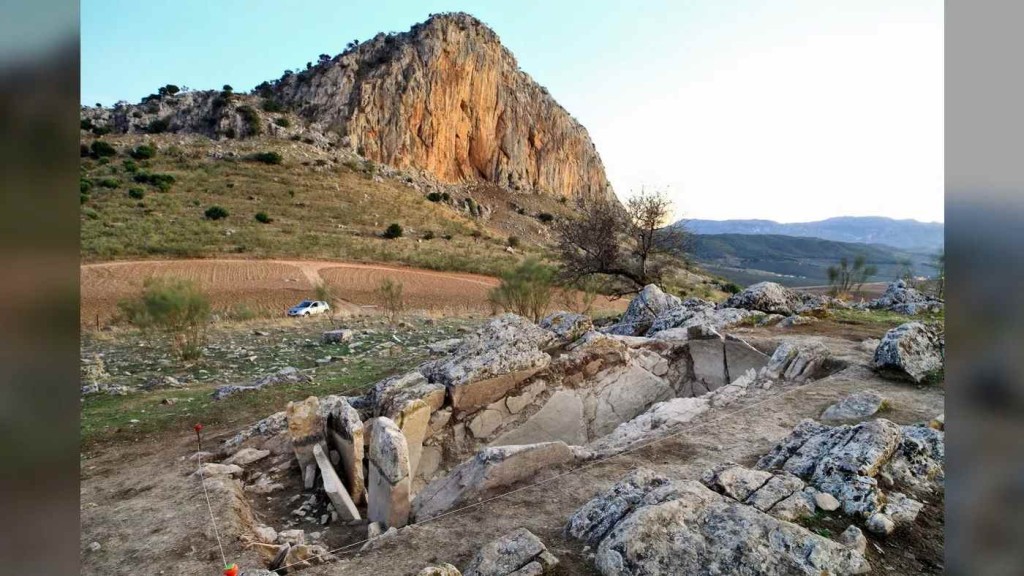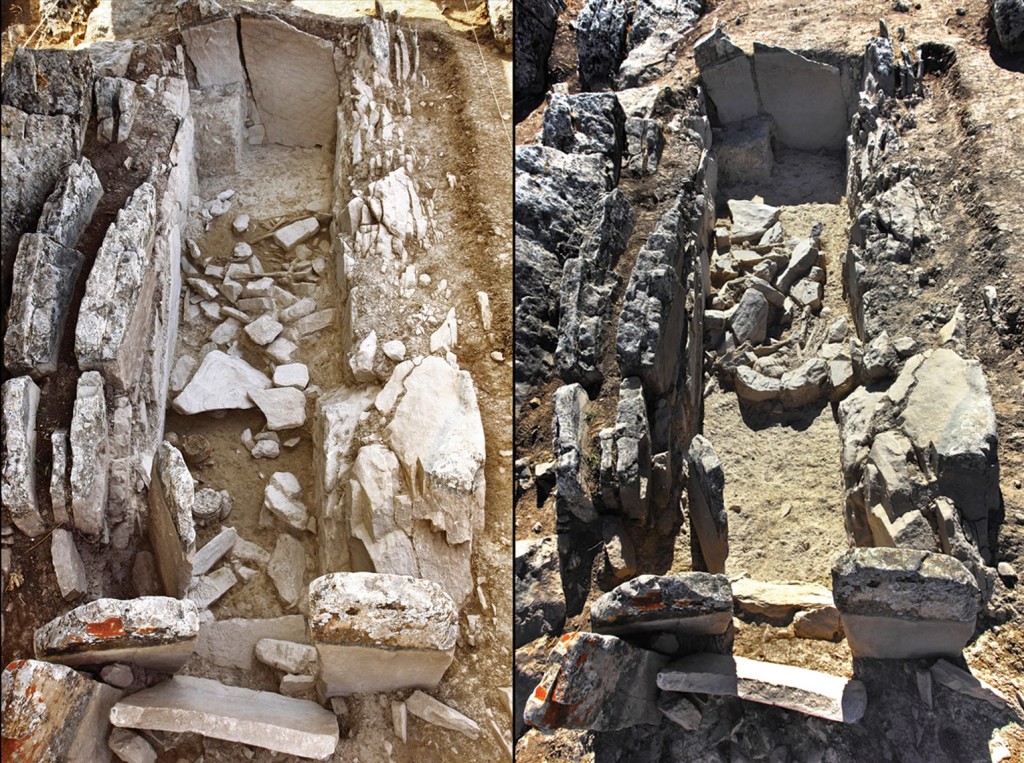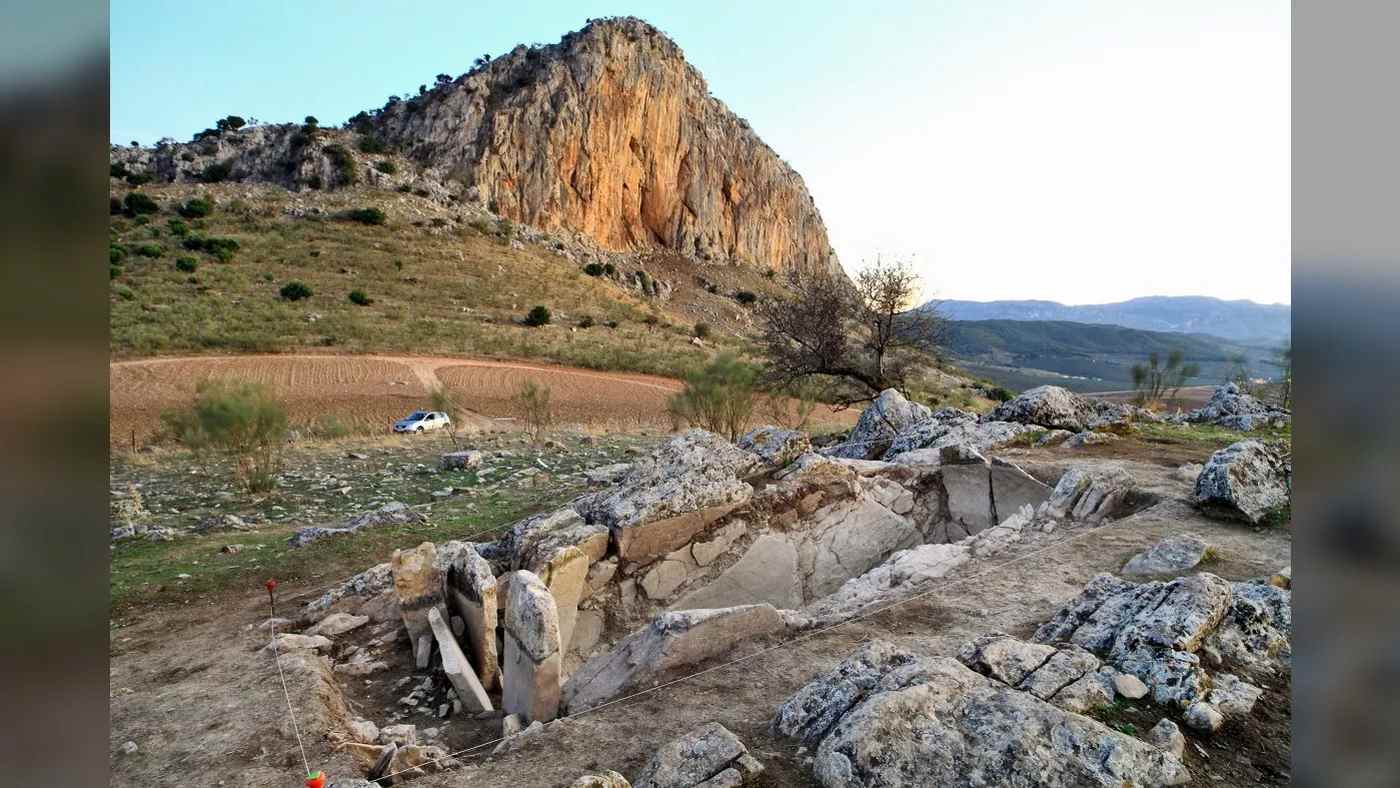
Reprinted with permission from World at Large, an independent news outlet covering conflict, travel, science, conservation, and health and fitness.
Archaeologists working in Spain’s most famous archaeological site have uncovered a 5,400-year-old tomb that perfectly aligns to the summer solstice sunrise in such a way as to be described as “domesticated sunlight”.
That strange term is used because of the rich variety of designs that appear in shadow on a stone stele on the right-hand side of the tomb when hit by the light of the rising sun on June 21st, producing an effect not unlike Newgrange in Ireland.
The tomb was discovered in the Antequera Dolmens UNESCO World Heritage Site near the town of Antequera, southern Spain. The 6,100-acre (2,446-hectare) site contains a mix of megalithic and dry stone Neolithic burial architecture unsurpassed in all of Europe, many of which contain archaeo-astronomical alignments.
“Newgrange is much bigger and more complex than the tomb we have discovered [in Spain], but they have something in common — the interest of the builders to use sunlight at a specific time of the year, to produce a symbolic—possibly magic—effect,” Leonardo García Sanjuán, an archaeologist at the University of Seville, told Live Science reporting on the discovery.
In the case of this tomb, called Piedras Blancas, or “White Stones” the base had exposed bedrock layers that tilted away from the sunrise, and so workers deliberately carved out a channel for light to enter and dance with shadows upon the walls inside.
The tomb was found quite near a remarkable limestone formation called La Peña de los Enamorados—the Rock of the Lovers—named after a legend that says two star-crossed lovers once killed themselves by jumping off it. It’s even closer to the Matacabras rock shelter, which is adorned with pictographs thought to be painted about 5,800 years ago.
“Antequera illustrates the power by which nature presided over the Neolithic worldview, inspiring and guiding the creation of monuments,” Sanjuán and his colleagues wrote in a paper on the site, published in Antiquity. “Is it mere chance that the largest and most sophisticated Neolithic monumental landscape in Iberia is in a region with not one but two remarkable natural formations?”
“Due to their different textures and carbonate content, processes such as dissolution, gelation, and wind action have differentially dissolved the limestones to form corridors, sinkholes, and caves. Neolithic settlers in the region may not have understood the formation processes that created El Torcal, but for a millennium and a half they lived among geological towers, corridors, and chambers that very much resembled a natural architecture”.

What was found inside
Built probably around 3,400 BCE, or 5,400 years ago, the site was still regularly inhabited or at least visited 1,400 years later at the onset of the Bronze Age in Andalusia, highlighting its importance in local culture.
The tomb contained a large “assemblage” of human remains, compared to other megalithic tombs at Antequera whereby no human bones have ever been found.
MORE SPANISH NEWS: Earliest Evidence of Modern Humans in Europe Dates back 65K years–After Jaw Bone is Discovered in Spain
At White Stones, the entrance to the tomb was free of all cut rock and human remains, and in fact played host to funerary offerings, to which 10 complete ceramic vessels bear witness. Further towards the back of the chamber, a complex arrangement of medium-sized stones tightly bonded with mud appears to have acted as a platform on which to place bodies and/or bones.
All this was recorded in the layer of earth closest to the bedrock, and dates to the oldest period of use around 3,000 BCE. Then about 500 years later, a dramatic transformation occurred which saw all these features buried with a layer of sediment.
In this layer were discovered two adult skeletons, one male, one female, of about 75% completeness, but nothing that could be construed as grave goods. The tomb was then subject to yet another renovation, with yet more skeletons.
Perhaps more interesting than anyone found inside were two slabs of rock that made up the right-hand side wall. The first, covered in undulating wave or scale-like shapes, was taken from an area that used to make up the shallow seabed. It was on this rock that the light from sunrise on the summer solstice would fall.
OTHER PREHISTORIC DISCOVERIES: Prehistoric Human Footprints Unearthed in Spain are Nearly 300,000 Years Old and Unique in All of Europe
Just below it, two flat stones were affixed to the bedrock of the tomb’s floor with mud mortar, which point directly to the rising sun on the solstice circ. 3,400 BCE. The orientation of the pointing stone passes exactly through the gap between the eastern end of the wall and two stones placed there, perfectly channeling the light onto the stone with the wave patterns.
“These people chose this stone precisely because it created these waving, undulating shapes,” Sanjuán told Live Science. “This was very theatrical… they were very clever in producing these special visual effects”.
A European thing
The authors note in their study that Neolithic Europeans in Spain, Ireland, England, and even Sweden, have aligned megalithic structures to solar movements, such as sunrise or sunset during the solstices, or the vernal and autumn equinox.
Sanjuán notes that the importance of the sun is of obvious focus: the sun was the center of the worldview for Neolithic Europeans. It kept them warm, allowed them to see, grew plants, melted the snow, and guided the changing of the seasons.
MORE ARCHAEOLOGY NEWS: 7,000-year-old Road Uncovered in Croatia is Paved in Stone–A ‘Sensational Find’
The Dolmen de Menga pictured above is one of the largest in Europe, but it isn’t aligned with any astronomical event. Instead, its opening points directly at La Peña de los Enamorados, with White Stones at its base.
Clearly, the hill was of great importance to the people of Neolithic Antequera, but why such an enormous megalithic monument would be made to point at a much smaller one, by comparison, was not something the archaeologists could answer at this time.
At the end of their work, they had nevertheless proven once again the incalculable value of Antequera for understanding the history of Europe.




















